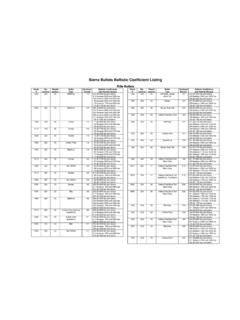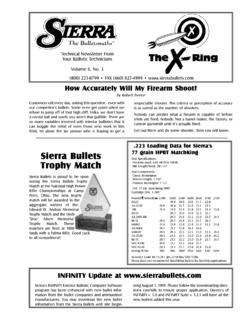Transcription of Volume 10 Number 1 - Sierra Bullets
1 Sierra Bullets -The Bulletsmiths Archive Past X-Ring Current Issue X-Ring Last Issue X-Ring PDF Archive Volume 10 Number 1 Technical Newsletter FromYour Ballistic TechniciansVolume 10, No. 1 How Deep Should Bullets be Seated in 9mm Cases By Robert TreeceA caller to our tech service referenced a loading data source and was confused about the different 's (over all lengths) mentioned. Well, sorry, but there is no catch-all answer to that the bullet companies do have different shapes of projectiles when offering a similar product. This can change length to a degree that requires adjustment of seating depth to allow correct cycling.
2 Load data should be adjusted because of seating depth and construction. By construction I mean that the projectiles can be made using different jacket materials, different hardness of lead, bearing surface length variations, plus different ogive angle and different base thickness. You should establish according to recommended guidelines of manufacturer (if available) and functioning capability for feeding the loaded is mm? I Thought it Stood for .30 Caliber (.308") By Robert TreeceThat is half right!I'm sure you've heard of .30 Caliber (.29999") ( ) -- that refers to the initial bore that is drilled into the barrel for making one that will use.
3 308" Bullets ; rifling, or grooves, are then most commonly "pressed" or cut, giving the or .308" groove diameter. Jacketed Bullets should be the diameter of the grooves, and lead Bullets normally .001" larger. If you do the math: x .03937 (a conversion # to change from mm to inches) = .29999" / hence .30 caliber and from a dimensional listing on our product catalog that also shows " " mentioned with our .308 diameter Bullets ; this computes as x .03937 = .30787 / hence .308", the actual bullet diameter--good shooting! (1 of 5)7/10/2003 3:26:49 AMSierra Bullets -The BulletsmithsDetermining Twist By Rich MachholzFrequently we ask callers "what is your twist" and the response is "well I'm not sure".
4 There is an easy solution. You can determine the twist rate of your barrels quite easily by using a cleaning rod with a tight fitting patch or brush and a Sharpie Marker. Start the moist patch on a jag and push into the barrel at the muzzle, making certain the rod rotates freely and the jag is snug in the rod. Pull the patch to near the muzzle and make a witness mark on the rod and handle so you can tell when you have achieved one complete revolution and make a mark at the muzzle around the rod. Now, push the rod into the barrel, watching index mark on the handle. When the rod has made one complete revolution make another mark around the rod at the muzzle.
5 Withdraw the rod, watching the index mark to verify the revolution. If all goes well, one revolution will be at your first mark on the rod. All you need to do is measure the distance between the two marks on the rod and that will be one turn in twelve inches or what ever the measurement between the marks might By Duane SiercksNo, this article is not about studying for finals but getting ready for fall hunting season. We commonly encounter callers that are trying to prepare at the last minute and we all know the frustration of "Things Ain't Workin'" syndrome. This is a good time for developing loads and fine tuning that load or changing out that old scope you have been meaning to upgrade and maybe try that "new" powder that may be just the ticket.
6 It will be better to find out that you might have a problem or need to change things now while you have time and also while Bullets , powders, etc. are readily available. Hopefully you have never been caught when your dealer or distributor has had a run on supplies due to the hunting season starting soon, but if you have, you know what I mean. Remember, if you have questions or need suggestions, give us a call at on Progressive Presses By Carroll PilantWith the need for some high volumes of ammo for IPSC, IDPA, NRA Action Pistol, and other types of shooting, many shooters have turned to progressive presses for their reloading needs.
7 Many shooters want to go to a progressive press but are afraid to, from all the talk about double charges, no charges, varying charge weights and other problems. There are a few simple procedures that will alleviate these problems that are usually caused by poor loading techniques in the beginning. One of the main problems with people trying to operate a progressive press is the speed they try to reload. They try to run the press just as fast as they can, which in turn, doesn't give the charge bar enough time to dump powder and refill uniformly. Plus, as they rotate the case from station to station it can sling powder out of the case.
8 In presses such as the Dillon 550, the granules of powder then get carried around by the shell plate and eventually fall into the cup for the primer seating stem and puts dents in each primer you seat. To eliminate this damage to the primer cup you should check every 25 rounds to make sure there is no residue. Double charges can be solved by using a powder that fills the case up enough, so that if you should for any reason, try to double charge a case, the powder will be at the top of the case or running over, which is a sure tip-off that something isn't right. You should notice this immediately when you are trying to seat a bullet.
9 (If you aren't that attentive, you need to take up a hobby besides reloading anyway!). With the case 2/3 to 3/4 full with each charge, you can visually see the powder in each case, so you know your powder measure isn't clogged up and not dumping powder also. I have a rule in my reloading room, that if you ever stop the stroke on the handle for ANY REASON, such as a bullet tipped over sideways and you backed the ram up slightly to straighten the bullet, YOU DO NOT FINISH THAT STROKE, until you are sure it didn't dump a partial charge of powder. Either pull the case out (on new cases, you can look down inside while it is still in the press and see if there is any powder, the shiny insides of the case will show it ) and make sure it is empty.
10 Then you can continue on if it is empty. If it isn't, pull the case and dump the powder back into the measure, put it back in the press and continue. In some circumstances, if you stop partially through a stroke, (2 of 5)7/10/2003 3:26:49 AMSierra Bullets -The Bulletsmithsthe charge bar may have moved over enough that is started to dump some of the powder and then when you lower the handle, it comes back and picks up a full load of powder and when you complete the stroke, you have a full load plus a partial load in the case you have just loaded. (This is once again where a powder that fills up much of the case, will tip you off that you have a problem) Pick powders that meter easily.




